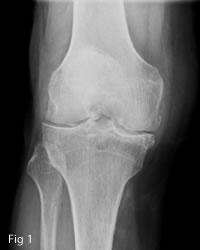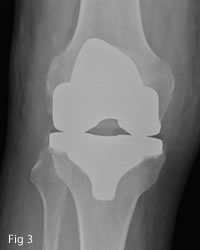Osteoarthritis of the knee
What is osteoarthritis?

Osteoarthritis (OA) is a chronic condition of joints in which there is a slow, progressive loss of the articular cartilage that lines the joint surface of the bone.
The knee is the most common of the large weight bearing joints to be affected by osteoarthritis (OA). Although there may be a predisposing factor such as a previous ligament injury or cartilage tear or pre-existing deformity, in most cases there is no obvious cause. OA is more common in people who are overweight and has a tendency to run in families.
Fig 1 Osteoarthritis of the knee
When does it occur?
Symptoms will usually begin in those over the age of 50 and become more common with increasing age. Younger people may occasionally be affected, generally due to a previous injury or joint abnormality.
What are the symptoms?

Pain, stiffness, swelling and the development of deformity are regular features. Pain is often worse after exercise and at night, stiffness is prominent after sitting or resting for any period and swelling may accompany symptoms of catching or giving way. Symptoms will deteriorate over time as the arthritis progresses, although severity will often vary over the months or with the weather.
Fig 2 Osteoarthritis following a fracture
What is the treatment?

Osteoarthritis is diagnosed from the history of the symptoms and their progress, examination of the joint affected and other joints and, in the later stages when operative treatment may be required, from an X-ray.
The early management is based around relief of pain, maintenance of movement and reduction in load. Education plays an important role in this process and advice from a physiotherapist is invaluable.
There is a wealth of information about the early management including guidelines from NICE.
Fig 3 Total knee replacement
Who needs a knee replacement?
Knee replacement surgery is considered when non-operative treatment can no longer control the symptoms. The knee is the most common joint to be replaced and a total knee replacement is the most common procedure. This is a major operation during which your surgeon will remove the damaged joint surfaces and replace them with a metal and plastic implant.
The aim of the procedure is to relieve pain and restore movement and function.
The success of the procedure will depend upon the rehabilitation in addition to the surgery and it will in general take up to a year to recover fully and realise the full benefit of the procedure.
Bristol
Contact us on
0117 980 4037
or
0117 980 4046

